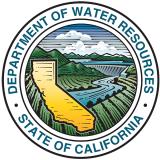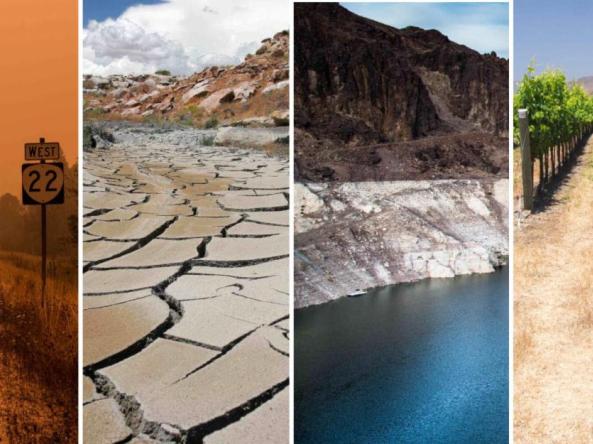Southern California-Nevada Benefits from the Monsoon, but Severe Drought (D2) or Worse Continues.
Register here for the September 26 California-Nevada Drought & Climate Outlook Webinar.
Key Points
- Monsoonal rains and moisture have improved drought conditions and reduced fire risk in areas of California and Nevada. Yet more than 98% of the region remains in severe drought (D2) or worse.
- Through the end of August, enhanced rainfall across the monsoon regions of the Southwest is strongly favored to continue, while drought persistence is favored for the West ahead of the core wet season. La Nina is expected to continue into the fall and winter.
- The Bureau of Reclamation released its Colorado River Basin 24-Month Study and announced shortage declarations.

The U.S. Drought Monitor (USDM) is updated each Thursday to show the location and intensity of drought across the country. Drought categories show experts’ assessments of conditions related to dryness and drought including observations of how much water is available in streams, lakes, and soils compared to usual for the same time of year.
California/Nevada conditions as of August 16, 2022:
- 99.76% of California is experiencing Moderate (D1) to Exceptional (D4) Drought (26.59% in D3, 16.57% in D4)
- California population in drought: 37,243,383
- 100% of Nevada is experiencing Moderate (D1) to Exceptional (D4) Drought (52.7% in D3, 0% in D4)
- Nevada population in drought: 2,700,551
U.S. Drought Monitor Categories
The U.S. Drought Monitor (USDM) is updated each Thursday to show the location and intensity of drought across the country. Drought categories show experts’ assessments of conditions related to dryness and drought including observations of how much water is available in streams, lakes, and soils compared to usual for the same time of year.
California/Nevada conditions as of August 16, 2022:
- 99.76% of California is experiencing Moderate (D1) to Exceptional (D4) Drought (26.59% in D3, 16.57% in D4)
- California population in drought: 37,243,383
- 100% of Nevada is experiencing Moderate (D1) to Exceptional (D4) Drought (52.7% in D3, 0% in D4)
- Nevada population in drought: 2,700,551
Current Conditions
- Over the past 3 months (primarily the past 4–8 weeks), drought has improved in the monsoon-impacted areas of California and Nevada, according to the U.S. Drought Monitor. While Nevada currently has no exceptional drought (D4), more than 98% of the region remains in severe drought (D2) or worse.
- California has had its driest and Nevada its second driest start to a calendar year. However, recent rains and moisture have helped the acres burned stay below average for this time of year in California. Monsoonal rains caused severe flooding in Death Valley in the beginning of August.
- Dead fuel moistures are high throughout much of the Central Valley but remain near-normal or below-normal in the rest of the region. Several large fires occurred recently in California, including the Oak Fire and McKinney fires. The Klamath River experienced a massive debris flow from McKinney, which impacted fish.
- Evaporative demand—the ‘thirst of the atmosphere’—over the past 3 months has been high in the Central Valley. More recently over the past two weeks, it has been low through California and Nevada.
- Both evaporative demand and lack of precipitation are drivers of the current drought since it began in October of 2019. Evaporative demand is the primary driver in much of the Central Valley while lack of precipitation has been the primary driver in northern California and the Sierras.
- Soil moisture remains low across the Central Valley and parts of southwest Nevada, but is near- or above-normal throughout other parts of the region.
- On August 11, California Governor Newsom announced California’s latest actions to increase water supply and adapt to more extreme weather patterns caused by climate change, as outlined in California’s Water Supply Strategy, Adapting to a Hotter, Drier Future. On August 12, he also presented several climate proposals to the State legislature.
- On August 16, Metropolitan Water District’s Board of Directors adopted a resolution affirming Metropolitan’s call to action and commitment to regional reliability for all member agencies.
- On August 16, the Bureau of Reclamation released its Colorado River Basin 24-Month study and announced urgent action to improve and protect the long-term sustainability of the Colorado River System. In June 2022, Commissioner Touton testified before the U.S. Senate Committee on Energy and Natural Resources and called on water users across the Basin to take actions to prevent the reservoirs from falling to critically low elevations that would threaten water deliveries and power production.
- U.S. Secretary of the Interior Deb Haaland visited the Central Valley on August 16 with farmers and other federal and state leaders, including Wade Crawfoot, California’s Secretary of Natural Resources Agency, and Karen Ross, California’s Secretary of the California Department of Food and Agriculture, to discuss drought resiliency and investments.
- For more information, check out Living with Drought in Nevada and the California Water Watch.
How is drought affecting your neighborhood? Click to see drought indicators, outlooks, and historical conditions by city, county, and state, as well as sign up for alerts.
U.S. Drought Monitor 8-Week Change Map

Precipitation Conditions


Evaporative Demand Drought Index (EDDI)


Relative Contributions of Precipitation Deficit and Surplus Evaporative Demand

Drought and Climate Outlook
El Niño–Southern Oscillation (ENSO)
NOAA’s ENSO alert system status is currently a La Niña Advisory. La Niña is expected to continue, with chances for La Niña gradually decreasing from 86% in the coming season to 60% during December 2022–February 2023. For more information, check out the NOAA ENSO blog and how La Niña impacts the Western U.S.
Subseasonal to Seasonal Drought, Temperature, Precipitation, and Fire Outlooks
The National Weather Service’s Climate Prediction Center is forecasting above-average temperatures for most of the U.S., including California-Nevada, for September through November. For the same time period, precipitation in California-Nevada is forecasted to be below normal to equal chances of below/normal/above. Through the end of August, dynamical models strongly favor a continuation of enhanced rainfall across the monsoon regions of the Southwest, while drought persistence is favored for the West ahead of the core wet season.
According to the National Interagency Fire Center, large fires began to emerge in northern California towards the end of July as lightning followed prolonged hot and dry conditions. Northern California is expected to have above-normal significant fire potential through August into September. Above-normal potential is also expected in portions of the central and southern Sierra and foothills, as well as the central California coast through September. By October, only downslope wind favored areas of northern and southern California are forecast to have above-normal potential, with areas in southern California retaining potential in November. Critically flammable vegetation, in both the live and dead fuel types, will occur at times across a broad area of Northern California but will especially impact central and eastern areas during August, with less confidence in the trends for September and October. Near- to above-normal herbaceous fuel loading is found across the landscape and will not be altered until fall or winter storms begin. Other uncertainties regarding fuels that impact significant fire potential include large areas of blow-down with cured leaves and needles due to the intense December storms across portions of the Tahoe, Eldorado, and Six Rivers National Forests, as well as increased tree mortality that has returned in higher numbers compared to recent years due to the extended significant drought.
More details can be found here.
Seasonal Drought Outlook: August 18–November 30, 2022

Seasonal (3-Month) Temperature and Precipitation Outlooks


Significant Wildland Fire Potential Outlook: September 2022

Drought Early Warning Resources
Prepared By
Amanda Sheffield
California-Nevada DEWS Regional Drought Information Coordinator, NOAA/NIDIS, CIRES
Julie Kalansky
California Nevada Applications Program (CNAP), Scripps Institution of Oceanography
This drought status update is issued in partnership between the National Oceanic and Atmospheric Administration (NOAA), the California-Nevada Applications Program, a NOAA RISA team, and the Western Regional Climate Center at the Desert Research Institute to communicate the current state of drought conditions in California-Nevada based on recent conditions and the upcoming forecast. NIDIS and its partners will issue future drought status updates as conditions evolve.






